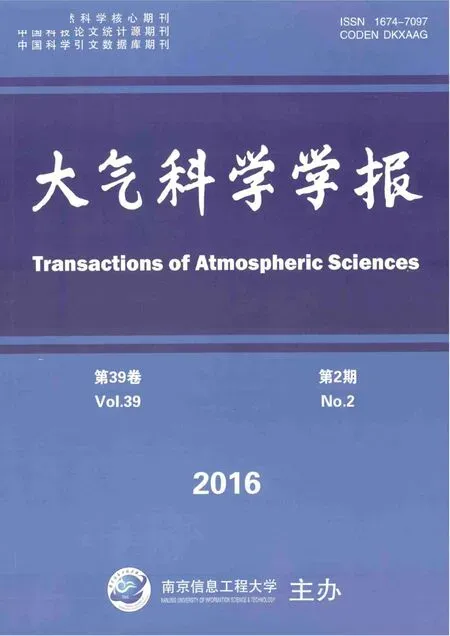西太平洋暖池热状态变异及其邻近地区对流活动特征
李业进,王黎娟

西太平洋暖池热状态变异及其邻近地区对流活动特征
李业进①②,王黎娟①*
① 南京信息工程大学 气象灾害教育部重点实验室/气候与环境变化国际合作联合实验室/气象灾害预报预警与评估协同创新中心/气候模拟与预测科技创新团队,江苏 南京 210044;
② 泗阳县环保局,江苏 宿迁 223700
2014-09-15收稿,2014-12-26接受
国家重点基础研究发展计划(973计划)项目(2012CB417403);江苏省高校自然科学研究重大项目(14KJA170004);江苏省自然科学基金项目(BK20131432)
利用1981—2011年共31 a夏季的GODAS月平均次表层海温资料,以5~366 m次表层垂直平均海温表征西太平洋暖池热含量,分析了西太平洋暖池热状态变异及其邻近区域对流活动特征。结果表明:1)暖池区热含量异常变化最大,其季节变化与海表温度季节变化高度一致,年际变率大于海表温度的年际变率。2)暖池热状态以整体一致性正异常为主,其时间系数较好地体现了暖池区次表层热状况的年际变异特征。3)暖池邻近地区对流活动与暖池热状态异常密切相关:当暖池偏暖(冷)时,菲律宾周围关键区对流活动显著增强(减弱),并且该关键区的对流活动受暖池热含量的影响可以追溯至前一年7月一直持续到当年9月。4)暖池热状态异常引起菲律宾周围关键区对流活动异常,进而激发出东亚地区夏季500 hPa高度场上自低纬度到中高纬度正、负、正的东亚—太平洋(EAP)遥相关型分布特征;暖池暖(冷)异常时对流层低层在菲律宾以东洋面形成一个异常的反气旋性(气旋性)偏差环流。
西太平洋暖池热状态热含量对流活动
西太平洋暖池是全球海洋表层温度(Sea Surface Temperature,SST)最高的海域(Wyrtki,1989;Cravatte et al.,2009),是引发强烈的大气对流,驱动Walker环流(Cornejo-Garrdo and Stone,1977)和Hadley环流(Hu,1997)系统最主要的热源地之一,对西太平洋副热带高压以及东亚气候异常(黄荣辉和孙凤英,1994;李万彪和周春平,1999;冯娟等,2010;陈颖曼等,2013)具有重要的影响。越来越多的证据表明,西太平洋暖池在海气耦合系统中占有十分重要的地位(Nitta,1987;Huang and Lu,1989;Wang et al.,2000;王东晓等,2001;岳彩军和陆维松,2009),其热状态变异会导致大气环流以及气候的异常变化(Kurihara and Kawahara,1986;Huang and Sun,1992;谢炯光等,1997;Ren and Huang,1999;Lu,2001)。Donguy et al.(1984)指出Walker环流的上升分支的位置随最大热含量区变化而变化,即暖池的热状态变异会影响其上空的对流活动。然而,对流活动的变化比较剧烈,不像海温那样稳定,它不仅受局地海温的影响,而且还受到热带地区大尺度大气环流的影响(Lau et al.,1997),因此,暖池区海温偏高并不说明其上空对流活动也一定强(Nitta,1990)。黄荣辉等进一步指出暖池及其上空的对流活动可以激发夏季东亚—太平洋型(EAP或PJ型)遥相关波列,与东亚夏季气候异常有着十分密切的关系(Huang,1992)。
海表温度(SST)和热含量(Heat Content,HC)是表征海洋热力状况的两种最常用的物理量,常被用来研究暖池的变异等方面特征(Chen and Hu,2003;Fang et al.,2004;Hu and Yu,2008;Cravatte et al.,2009)。研究表明,由于海水温度具有范围广阔的低水平梯度和垂直混合特性,暖池区SST变化较小,即使在ENSO期间,其变化也小于1 ℃。暖池因其水温高、分布范围广而拥有极为丰富的热含量,而强烈的热含量变异会影响其上空的大气环流特征,并对气候产生重要作用(陈永利和胡敦欣,2003)。可见,热含量在表征暖池热状态变化时更具优越性。
本文以热含量为关键参数,研究西太平洋暖池热状态变异及其邻近地区对流活动特征,以此揭示西太平洋暖池热状态异常特征以及暖池邻近地区对流活动的前期信号,除了能更清楚地认识西太平洋暖池和对流活动之间的关系,前期热含量异常信号还可以对东亚夏季气候预测提供一定的参考。

图1 1981—2011年热带太平洋夏季SST(28 ℃粗实线)和SST(a;阴影区)、HC(b;阴影区≥0.6 ℃)的标准差(单位:℃)Fig.1 Annual tropical Pacific summer SST(thick solid contour:28 ℃) and the (a)SST standard deviation(shaded area) and (b)HC standard deviation(shaded area:≥0.6 ℃) distribution during 1981—2011(units:℃)
1 资料和方法
资料包括:1)NOAA V3b版本延长重构的海表温度资料,水平分辨率为2°×2°;2)GODAS月平均次表层海温资料,水平分辨率为1.0°×0.333°,根据需要选用上部27层(共40层),即5、15、25、35、45、55、65、75、85、95、105、115、125、135、145、155、165、175、185、195、205、215、225、238、262、303、366 m;3)NCEP/NCAR提供的逐月再分析位势高度场、风场和NOAA提供的向外长波辐射(OLR)数据,水平分辨率为2.5°×2.5°。以上资料所取时段均为1981年1月—2011年12月。
热含量计算参考Hasegawa and Hanawa(2003)的方法,以366 m以上共27层的垂直平均海温表征海洋上层的热含量,以之反映海洋上层的热状态。
2 西太平洋暖池基本特征
2.1西太平洋暖池SST、HC标准差分布
从暖池区域位置(28 ℃等温线包围的区域)与海表温度异常变化最大的区域位置(图1a)来看,海表温度异常变化最大的区域位于暖池区域以东,较为均匀地分布在赤道两侧,最大变异达1.3 ℃。而从上层海洋热含量异常的标准差分布可以看出,热带西太平洋暖池区是太平洋上层海洋热含量异常变化最大的区域,南北半球巴布亚新几内亚和菲律宾海域各存在一个最大变异中心,最大变异达1.2 ℃,与海表温度的变异相当,这是由于南北赤道流在热带太平洋西边界的转向造成的。可见,暖池主体范围与热含量标准偏差最大的区域基本一致(阴影部分,大于等于0.6 ℃)。综上,可以说明热带西太平洋上层海洋的热状态主要反映了暖池的变化,而热带西太平洋热含量的异常变化与ENSO循环有着紧密的联系(Tourre and White,1995;Mcphaden,1999)。
参考黄荣辉和孙凤英(1994)选取的西太平洋暖池区域,选取赤道以北区域(126~146°E,2~16°N)作为研究的西太平洋暖池区域(图1中黑框区域),此区域既是SST高值区,同时又是HC标准差大值区。

图2 西太平洋暖池区SST、HC的季节变化(a)以及SST、HC合成的年际变化(b)(单位:℃)Fig.2 The (a)seasonal variation and (b)synthetic interannual variability of the SST and HC of the WP(units:℃)
2.2西太平洋暖池热状态季节、年际变化
图2反映了暖池区域1981—2011年平均海表温度、热含量的季节以及年际变化特征。对于季节变化来说,SST最高出现在6月,达29.55 ℃,最低出现在2月,达28.01 ℃,月际最大差值1.54 ℃;HC最高出现在6月,达18.15 ℃,最低出现在1月,达17.05,月际最大差值1.1 ℃。总体上来看,二者均是夏季最高、春秋季次之,冬季最小,变化趋势高度一致,二者的相关系数高达0.68,通过了0.05信度的显著性水平的t检验,这反映了太阳辐射随纬度差异对暖池热状态季节变化所造成的影响。
二者的年际变化方面,均表现为明显的年际变化特征,相关系数高达0.69,通过了0.05信度的显著性水平的t检验,说明二者具有显著的正相关关系,且HC年际变率远大于SST,其年际异常与ENSO关系密切,而SST年际变化与ENSO关系不显著(李丽平等,2004),这也是本文选取热含量反应海洋上层热状态的一个因素。

图3 西太平洋暖池区HC与西太平洋暖池SST(a)以及赤道中东太平洋(80~160°W,10°S~10°N)SST(b)的时滞相关系数分布(虚线代表通过95%、99.9%置信度检验;“-”代表上一年,“0”代表当年)Fig.3 The time lagged correlation coefficient distribution of the WP HC and the (a)WP SST and (b)central and eastern equatorial Pacific(10°S—10°N,80—160°W) SST(shaded areas indicate statistical significance over the 95% and 99.9% confidence levels)
2.3西太平洋暖池SST对局地HC的贡献
为研究夏季暖池区域热含量与暖池区域海表温度以及赤道中东太平洋海表温度的具体关系,图3给出了暖池区域热含量与上述区域海表温度的时滞相关系数分布,可见,暖池区域热含量与热带太平洋海温场的相关系数分布存在以西太平洋暖池和赤道中东太平洋为主的正、负相关分布特征。正相关分布特征表明暖池区域的热含量主要受前期以及同期位于西太平洋暖池区域SST的影响,整体上呈现的是“三峰型”分布特征,其中同期1、2、3月的相关性最为显著,通过了99.9%置信度检验。负相关分布特征表明,暖池区域的热含量变化与赤道中东太平洋SST存在反相关关系。上述分析结果表明,暖池区域的SST对局地热含量存在一定贡献。

图4 夏季西太平洋暖池区热含量距平EOF第一模态(a)以及第一模态的时间系数PC1(柱状)、暖池区域平均热含量标准化距平序列(实线)(b)(虚线为一元线性趋势线)Fig.4 The (a)first EOF mode of the HC anomalies of the WP in summer,and (b)time coefficient PC1(bars) and the WP area-averaged HC anomalies standardized sequence(solid line)(dashed is the linear trend line)
3 西太平洋暖池热状态变异
3.1西太平洋暖池热状态时空变化
对1981—2011年共31 a夏季西太平洋暖池区(126~146°E,2~16°N)热含量距平作经验正交分析(EOF),其中第一模态占66.57%的方差贡献,远大于第二模态11.83%方差贡献,因此该模态是暖池区热含量的主导模态。如图4a所示,第一模态呈现的是暖池区整体一致性正异常分布特征,其中以8°N为中心的赤道太平洋西部出现一个大值带,位置与热含量异常变化最大值位置基本一致(图1b),反映出北赤道逆流和赤道流相互作用所致的暖水积聚下沉或深层冷水涌升的特点。该模态的时间系数PC1与西太平洋暖池区域平均热含量标准化距平的相关系数高达0.98,通过了99.9%置信度检验,可见,第一模态的时间系数主要体现了夏季暖池区热含量的年际变异特征。从一元线性趋势线上可以很明显看出,该时间系数在1997年以后由负转正,体现了暖池区域热含量呈增温趋势。
根据图4b,定义PC1为热含量指数,即HCI。为便于合成分析,对暖池进行冷暖异常年份划分。划分标准为:冷暖异常年份是指HCI小于(大于)-1(1)的年份。从图4b中可知冷异常年为:1991、1993、1997、2003、2004共5 a;暖异常年1984、1999、2000、2008、2009、2010共6 a,冷暖异常年份总数约占研究时段(共31 a)的1/3。
为研究西太平洋暖池区热状态变异与暖池以外区域的热含量变化的联系,计算了该区域平均热含量与其以外地区热含量的相关系数(图5),可以看出存在大范围的显著正负相关区域,大致以160°W为界,以西为正相关区域,以东则为负相关区域。其中,印度洋东部海域、热带西太平洋、以及西北太平洋均是超过99.9%置信度检验的正相关区。这表明西太平洋暖池区一旦发生暖异常,暖异常区域不仅是它本身,而且还有其相关的海域,这体现了暖池区热含量变异具有局地性特征。因此研究暖池热状态变异对大气的影响也不仅是研究暖池区域本身,同时还得考虑与其存在显著相关区域的影响。

图5 1981年1月—2011年12月暖池区热含量与其以外地区热含量的同期相关分布(阴影区表示通过置信度99.9%的显著性检验)Fig.5 The contemporaneous correlation distribution between the WP HC and the HC outside the WP from January 1981 to December 2011(shaded area represents the ≥99.9% confidence level)
3.2西太平洋暖池区不同深度异常海温变化
为分析解暖池区海温场在不同深度上的变化特征,图6给出了暖池区(126~146°E,2~16°N)不同深度上海温距平的变化曲线。可以发现,暖池区域不同深度海温场均具有明显的年际变化特征。在不同深度的海温变化过程中,表层海温变化振幅最小(-1 ℃和1 ℃之间)。随着深度的增加,海温变化振幅增大,100~200 m处达到最大(-4.0 ℃和4.0 ℃之间)。随着深度的继续加深,异常海温变化振幅又开始减小。另外,还可以看出,在暖池表层和366 m处增温趋势缓慢,而次表层(100~200 m)海温增温趋势相对较快。

图6 西太平洋暖池366 m(a)、238 m(b)、155 m(c)、75 m(d)、5 m(e)深度海温距平的变化特征以及暖池区域海温距平深度—时间变化(f)(单位:℃;虚线表示一元线性趋势线)Fig.6 The temperature anomalies of different depths in the WP:(a)366 m;(b)238 m;(c)155 m;(d)75 m;(e)5 m(dashed lines are the linear trends);(f)WP regional SST anomaly depth-time variation(units:℃)
由图6f可以清楚地看出,暖池区域次表层海温的的年际振荡较为显著,显著的冷(暖)海温异常主要发生在次表层(50~250 m),尤其是100~200 m,最大变温绝对值达3 ℃,而最大冷(暖)海温恰好对应于ENSO循环过程中的El Nio(La Nia)事件。
通常以28 ℃等温线所在海水深度代表暖池厚度,以20 ℃等温线所在海水深度代表温跃层深度。图7给出了暖池分别沿经向和纬向平均的次表层海温随深度的剖面。纬向上来看,总体上温跃层深度(暖池厚度)分布较为均匀,海温均方差在100~200 m左右深度、128~135°E位置处达到最大。经向上来看,总体上温跃层深度(暖池厚度)是两边深(厚)中间浅(薄),温跃层最深处和暖池最厚处与暖池位置有关,海温均方差最大值所在深度与经向平均相近,经向位置位于3~10°N。平均来看,夏季暖池厚度在50 m以浅,温跃层深度在200 m以浅。
4 西太平洋暖池邻近地区对流活动特征
热带西太平洋暖池附近的海表温度为全球最高,海洋和大气之间有着强烈的热量、水汽的交换,使得该地区成为全球热带主要的对流活动中心之一(Chen et al.,2004),对我国的气候也有重要的影响。下面将重点分析西太平洋暖池热状态异常时邻近地区对流活动以及环流场特征。
4.1西太平洋暖池冷、暖异常年邻近地区对流活动特征
为分析暖池热状态异常与暖池邻近地区对流活动特征,根据已经挑选出的西太平洋暖池冷、暖异常年份对OLR场进行合成分析。图8给出了夏季西太平洋暖池偏暖、偏冷年OLR异常分布。可见,当暖池偏暖时(图8a),菲律宾周围地区呈现的是大范围的负异常分布特征,也即当夏季暖池偏暖时,菲律宾周围对流活动偏强,暖池偏冷时(图8b)对流活动情况则与之相反。从差值场(图8c)上可以看出,暖池热含量异常时,菲律宾以东地区对流活动异常最为显著,因此本文将此区域126~146°E、16~26°N(图8中黑框区域)选为菲律宾周围对流活动关键区,以反映暖池邻近地区对流活动特征。

图7 2~16°N平均的次表层海温纬向—深度剖面(a),以及126~146°E平均的次表层海温经向—深度剖面(b)(单位:℃;阴影区表示均方差大于等于1.8 ℃)Fig.7 (a)2—16°N-averaged subsurface temperature zonal-depth profiles;(b)126—146°E-averaged subsurface temperature warp-depth profiles(units:℃;shaded area shows the standard deviation≥1.8℃)

图8 夏季西太平洋暖池偏暖(a)、偏冷(b)年份OLR异常分布,以及偏暖、偏冷年份OLR差值分布(阴影区通过0.1信度的显著性检验)(c)(单位:W/m2)Fig.8 OLR anomaly map of the (a)warmer and (b)colder summer years of the WP,and (c)the OLR difference map between the warmer and colder summer year(shaded area significant at the 0.1 level)(units:W·m-2)
由图9可见,菲律宾周围关键区夏季对流活动与西太平洋暖池热含量的相关整体上呈现出负相关的分布特征,自前一年7月开始就呈现显著的负相关关系(通过0.1信度的显著性检验),这种显著的负相关关系可以一直持续到当年9月,而后相关性开始减弱。整体上看,相关系数呈“双峰”型分布特征,相关性最大的两个月分别是前一年的9月和当年的5月。以上分析,同时也从侧面反映了热含量异常对对流活动的影响具有较强的持续性特征。
4.2西太平洋暖池冷、暖异常对东亚夏季大气环流影响
图10a反映了菲律宾周围关键区夏季对流活动异常与500 hPa高度场异常之间的联系。可见,在菲律宾周围对流活动异常的激发下,东亚地区夏季500 hPa高度场上自低纬度到中高纬度呈现的是正、负、正的东亚—太平洋(EAP)遥相关型分布特征。低纬度的正相关区对应着西太平洋副热带高压,中部的负相关区域对应着梅雨锋,而高纬度的正相关区域则代表了鄂霍次克海阻高。这种环流形势表明,当菲律宾周围对流活动增强时,有利于西太平洋副热带高压控制江淮地区,但其强度减弱,同时鄂霍次克海阻高减弱,使得冷空气南下减弱,进而影响江淮地区夏季降水以及对流活动。
为研究东亚地区大气环流对西太平洋暖池热状态异常的响应,对显著暖异常年和冷异常年夏季对流层低层风场异常作了合成分析。从图10b可以看出,暖异常时,对流层低层菲律宾以东洋面有一支反气旋性偏差环流(中心位于图中“A”字所在的位置),它大大加强了西太副高系统南侧的东风强度,并向西南方向延伸,影响了热带西南季风向东亚地区的发展,这支偏差气流西侧的偏南风在台湾海峡转向形成一支气旋性偏差环流,该偏差气流北侧的偏东气流与日本群岛附近的高压系统南侧的偏东气流合并,一起转向大陆,形成异常的副热带西南季风。从图10c可以看出,冷异常年的风场距平合成与暖异常年的差异非常明显,在冷异常年,西太平洋上空对流层低层菲律宾以东洋面有一支气旋性偏差环流(中心位于图中“C”字所在的位置),而日本群岛附近有一支反气旋性偏差环流,带来的结果是二者中部交汇地带有一支异常的偏东气流影响我国东南沿海地区,对我国东南沿海地区季风以及降水有重要影响。

图9 菲律宾周围关键区(126~146°E,16~26°N)夏季区域平均OLR距平与HCI的时滞相关系数序列(虚线通过0.1信度的显著性检验)Fig.9 The time lagged correlation coefficient sequence of the key area’s averaged OLR anomaly around the Philippines(16—26°N,126—146°E) with the HCI(dashed line indicates statistical significance at the>90% confidence level)

图10 1981—2011年夏季对流关键区(126~146°E,16~26°N)区域平均OLR距平与500 hPa高度场距平的相关系数分布(a;阴影区表示通过0.1信度的显著性检验),以及西太平洋暖池偏暖(b)、偏冷(c)年合成850 hPa风场异常分布Fig.10 (a)The correlation coefficient distribution of the regional averaged OLR anomalies with the 500 hPa height field anomaly(shaded areas are statistically significant at the>90% confidence level),and the (b)warmer and (c)colder wind anomaly at 850 hPa,during 1981—2011
综上,西太平洋暖池热状态异常引起菲律宾周围对流活动异常,进而激发出东亚地区夏季500 hPa高度场上自低纬度到中高纬度正、负、正的东亚-太平洋(EAP)遥相关型分布特征;环流场上,暖池暖(冷)异常时,对流层低层在菲律宾以东的西太平洋洋面形成一个异常的反气旋性(气旋性)偏差环流,对东亚季风以及我国东部地区降水有重要影响。
5 结论
本文以夏季西太平洋暖池次表层热含量表征暖池热状况,分析了暖池热状态变异及其邻近地区对流活动特征,得到以下主要结论:
1)暖池区热含量异常变化最大,其季节变化与海表温度的季节变化高度一致,年际变率大于海表温度的年际变率,暖池区域海表温度对局地热含量存在一定贡献。
2)暖池热状态以整体一致性正异常为主,其时间系数较好地体现了暖池区次表层热状况的年际变异特征,暖池在100~200 m深度具有最大的海温变异,平均而言,暖池厚度在50 m以浅,温跃层深度在200 m以浅。
3)暖池邻近地区对流活动与夏季暖池热状态异常密切相关,当暖池偏暖(冷)时,菲律宾周围关键区对流活动显著增强(减弱),并且关键区的对流活动受热含量的影响可以追溯至前一年7月一直持续到当年9月。
4) 暖池热含量异常可以引起菲律宾周围关键区对流活动异常,进而激发出东亚地区夏季500 hPa高度场上自低纬度到中高纬度正、负、正的东亚—太平洋(EAP)遥相关型分布特征;环流场上,暖池暖(冷)异常时对流层低层在菲律宾以东的西太平洋洋面形成一个异常的反气旋性(气旋性)偏差环流。
References)
Chen G,Fang C,Zhang C.2004.Observing the coupling effect between warm pool and “rain pool” in the Pacific Ocean[J].Remote Sens Environ,91(2):153-159.
Chen Y,Hu D.2003.Influence of heat content anomaly in the tropical warm pool region on onset of South China Sea summer monsoon[J].Acta Meteor Sinica,17:213-225.
陈颖曼,曹杰,王传辉.2013.中国东南部冬季降水变化及环流特征[J].大气科学学报,36(3):323-330.Chen Y M,Cao J,Wang C H.2013.Precipitation variation over southeastern China in winter and its circulation pattern[J].Trans Atmos Sci,36(3):323-330.(in Chinese).
陈永利,胡敦欣.2003.南海夏季风爆发与西太平洋暖池区热含量及对流异常[J].海洋学报,25(3):20-31.Chen Y L,Hu D X.2003.The relation between the South China Sea summer monsoon onset and the heat content variations in the tropical western Pacific warm pool region[J].Acta Oceanologica Sinica,25(3):20-31.(in Chinese).
Cornejo-Garrdo A G,Stone P H.1977.On the hear balance of the Walker circulation[J].J Atmos Sci,34:1155-1162.
Cravatte S,Delcroix T,Zhang D,et al.2009.Observed freshening and warming of the western Pacific warm pool[J].Climate Dyn,33(4):565-589.
Donguy J R,Eldin G,Morliere A,et al.1984.Wind and thermal conditions along the Equatorial Pacific[J].J Mar Res,42:103-121.
Fang L,Chen G,Fang C,et al.2004.An investigation of recent western Pacific warm pool variabilities based on AVHRR/SST[J].Journal of Ocean University of China(English Edition),34:103-108.
冯娟,管兆勇,王黎娟,等.2010.夏季热带中太平洋SST异常型与中国东部夏季气候异常的关系[J].大气科学学报,33(5):547-554.Feng J,Guan Z Y,Wang L J,et al.2010.Impacts of central equatorial Pacific SSTA pattern on precipitation and temperature in East China in summer[J].Trans Atmos Sci,33(5):547-554.(in Chinese).
Hasegawa T,Hanawa K.2003.Heat content variability related to ENSO events in the Pacific[J].J Phys Oceangr,33:407-421.
Hu D,Yu L.2008.An approach to prediction of the South China Sea summer monsoon onset[J].Chinese Journal of Oceanology and Limnology,26:421-424.
Hu Z.1997.Interdecadal variability of summer climate over East Asia and its association with 500 hPa height and global surface temperature[J].J Geophys Res,102:19403-19412.
Huang R H.1992.The East Asia/Pacific pattern teleconnection of summer circulation and climate anomaly in East Asia[J].Acta Meteor Sinica,6(1):25-36.
Huang R H,Lu L.1989.Numerical simulation of the relationship between the anomaly of the subtropical high over East Asia and the convective activities in the western tropical Pacific[J].Adv Atmos Sci,6:202-214.
Huang R,Sun F.1992.Impacts of the tropical western Pacific on the East Asian summer monsoon[J].J Meteor Soc Japan,70:243-256.
黄荣辉,孙凤英.1994.热带西太平洋暖池的热状态及其上空的对流活动对东亚夏季气候异常的影响[J].大气科学,18(2):140-151.Huang R H,Sun F Y.1994.Impacts of the thermal state and the convective activities in the tropical western warm pool on the summer climate anomalies in East Asia[J].Chin J Atmos Sci,18(2):140-151.(in Chinese).
Kurihara K,Kawahara M.1986.Extremes of East Asian weather during the post ENSO years of 1983/84-Severe cold winter and hot dry summer[J].J Meteor Soc Japan,64:493-503.
Lau K M,Wu H T,Bony S.1997.The role of large-scale atmosphere circulation in the relationship between tropical convection and sea surface temperature[J].J Climate,10:381-392.
李丽平,王盘兴,何金海,等.2004.热带西太平洋热状况年代际和年际变化特征分析[J].热带气象学报,20(5):472-282.Li L P,Wang P X,He J H,et al.2004.Analysis of interdecadal and interannaual characterics of the tropical wesrtern pacafic warm pool heat status[J].J Trop Meteor,20(5):472-282.(in Chinese).
李万彪,周春平.1999.热带西太平洋暖池和副热带高压之间的关系[J].气象学报,56(5):619-626.Li W B,Zhou C P.1999.The relationship between tropical western Pacific warm pool and subtropical high[J].Acta Meteorologica Sinica,56(5):619-626.(in Chinese).
Lu R.2001.Interannual variability of the summertime North Pacific subtropical high and its relation to atmospheric convection and over the warm pool[J].J Meteor Soc Japan,79:771-783.
Mcphaden M.1999.Genesis and evolution of the 1997—98 El Nino[J].Science,283:950-954.
Nitta T.1987.Convective activities in the tropical western Pacific and their impact on the Northern Hemisphere summer circulation[J].J Meteor Soc Japan,64:373-390.
Nitta T.1990.Unusual summer weather over Japan in 1988 and its relationship to the tropics[J].J Meteor Soc Japan,68:575-587.
Ren B,Huang R.1999.Interannual variability of the convective activities associated with the East Asian summer monsoon obtained from TBB variability[J].Adv Atmos Sci,16:77-90.
Tourre Y M,White W B.1995.ENSO signals in global upper ocean temperature[J].J Phys Oceanogr,25:1317-1332.
Wang B,Wu R G,Fu R H.2000.Pacific-East Asian teleconnection:How does ENSO affect East Asian climate?[J].J Climate,13:1517-1536.
王东晓,谢强,周发琇.2001.南海及邻近海域异常海温影局域大气环流的初步试验[J].热带气象学报,20(3):82-89.Wang D X,Xie Q,Zhou F X.2001.Preliminary experiments for regional atmospheric circulation’s response to SST anomalies in south China Sea and its adjacent areas[J].J Trop Meteor,20(3):82-89.(in Chinese).
Wyrtki K.1989.Some thoughts about the West Pacific Warm Pool[C]//Proceedings of the Western Pacific international meeting and workshop on TOGA-COARE.New Caledonia:99-109.
谢炯光,秦冰冰,王静渊.1997.奇异值分解方法在季降水预测中的应用[J].气象学报,55(1):117-123.Xie J G,Qin B B,Wang J Y.1997.The application of singular value decomposition analysis in the prediction of seasonal rainfall[J].Acta Meteorological Sinica,55(1):117-123.(in Chinese).
岳彩军,陆维松.2009.1997/1998年El Nino事件发生、发展可能机制的进一步研究[J].大气科学学报,32(4):513-521.Yue C J,Lu W S.2009.Further study on possible mechanism for genesis and development of 1997/1998 El Nino event[J].Trans Atmos Sci,32(4):513-521.(in Chinese).
The variability of the thermal state over the western Pacific warm pool(WP) and the characteristics of its adjacent convective activities were studied using the monthly subsurface sea temperature data of GODAS from 1981 to 2011,together with a variety of statistical methods.The heat content(HC) was defined as the subsurface vertical temperature averaged from 5 to 366 m.The results demonstrate that:
(1)The WP area is the place where the HC has its largest variability,and its maximum value can reach 1.2 ℃ which is equivalent to the variation in SST.The depth layer from 100 to 200 m is the largest in terms of the change in subsurface temperature,usually changing from -4.0 ℃ to 4.0 ℃ Its seasonal variation is highly consistent with SST,and its interannual variability is much greater than that of SST.There is a certain degree of contribution to the HC from the SST of the WP.The thermal condition of the WP is closely related with ENSO events,as the largest cold(warm) SST anomalies correspond to El Nio(La Nia) events in the ENSO cycle.
(2)The dominant mode of HC is one of positive anomalies,and its corresponding time coefficient(PC1) shows evident annual variability in the sub-layer heat condition over the WP.A heat content index(HCI) was constructed by using the HC averaged over the WP region.Then,five colder years(HCI smaller than -1) and six warmer years(HCI larger than 1) were identified from the total 31 years,with the total abnormal years accounting for 1/3 of the whole period.
(3)There is a close relationship between the convective activities nearby the WP and the abnormal thermal state there in summer.The area of(16—26°N,126—146°E) around the Philippines was chosen as the key area to reflect the characteristics of convection of the adjacent areas of the WP,revealing that the convective activities over this critical region significantly enhance(weaken) when the WP is warmer(colder).The fact that convective activities are affected by the HC can be traced back to the July prior to a particular year,and through to the September of that current year,demonstrating the strongly persistent effects of the HC anomalies on the convective activities.
(4)HC anomalies of the WP cause abnormal convection around the Philippines,and thus stimulate the East Asia-Pacific teleconnection pattern,with a positive-negative-positive pattern of centers in the 500 hPa height fields from the low to the high latitudes over East Asia in summer.The region with positive correlation in the low latitudes corresponds to the western Pacific subtropical high;the negative correlation in the midlatitudes corresponds to the Mei-yu front;and the other positive correlation in the high latitudes represents the Okhotsk high.This circulation situation indicates that when the convective activities around the Philippines are enhanced,it is conducive to the western Pacific subtropical high controlling the Yangtze River region,with its intensity weakened.As a result,the precipitation and convective activities over the Yangtze River in summer will be affected,due to the weakened southward movement of cold air,which is the result of the weakened Okhotsk high.
In order to study the responses of the atmospheric circulation in East Asia to the thermal states of the WP,the anomalous wind fields in the lower troposphere were composited between the significant warmer and colder years.The results reveal that there is an abnormal anticyclonic(cyclonic) circulation bias in the lower troposphere over the western Pacific Ocean to the east of the Philippines when the WP is warmer(colder),which has an important influence on the East Asian monsoon and the precipitation over eastern China.
western Pacific warm pool;thermal state;heat content;convective activity
(责任编辑:张福颖)
Variability of the thermal state of the western Pacific warm pool and the characteristics of its adjacent convective activities
LI Yejin1,2,WANG Lijuan1
1KeyLaboratoryofMeteorologicalDisaster,MinistryofEducation(KLME)/JointInternationalResearchLaboratoryofClimateandEnvironmentChange(ILCEC)/CollaborativeInnovationCenteronForecastandEvaluationofMeteorologicalDisasters(CIC-FEMD)/ScienceandTechnologyInnovationTeamonClimateSimulationandForecast,NanjingUniversityofInformationScience&Technology,Nanjing210044,China;2EnvironmentalProtectionBureauofSiyangCounty,Suqian223700,China
10.13878/j.cnki.dqkxxb.20140915043
*联系人,E-mail:wljfw@163.com
引用格式:李业进,王黎娟.2016.西太平洋暖池热状态变异及其邻近地区对流活动特征[J].大气科学学报,39(2):156-165.
Li Y J,Wang L J.2016.Variability of the thermal state of the western Pacific warm pool and the characteristics of its adjacent convective activities[J].Trans Atmos Sci,39(2):156-165.doi:10.13878/j.cnki.dqkxxb.20140915043.(in Chinese).

